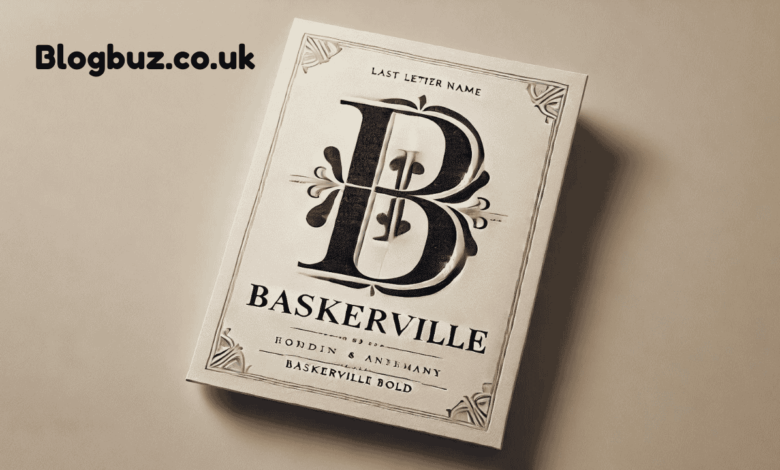Crafting Elegance: The Art of the Monogram With Baskerville Bol 3 Letters

In the world of personalized items and branding, the charm of a well-crafted monogram remains timeless. A monogram, a design comprising two or more letters woven together, transcends ordinary typography to symbolize identity and elegance. Among the plethora of typefaces available, the bold variant of Baskerville stands out for creating monograms, especially regarding the sophisticated arrangement of three letters. This article delves into the nuances of creating a Monogram With Baskerville Bol 3 Letters, exploring its historical roots, aesthetic appeal, and practical applications in today’s digital and print landscapes.
The Legacy of Baskerville: A Typeface for the Ages
John Baskerville, an eminent figure in 18th-century typography, introduced the Baskerville typeface, celebrated for its sharp, clean lines and modest embellishments. This typeface, originating from the traditional serif family, is characterized by its contrast between thick and thin strokes, making it a favorite for printed literature and upscale branding. The bold variant, Baskerville Bold, enhances these features, offering greater visibility and impact, which is ideal for monograms that aim to make a statement.
Understanding Monograms: A Blend of Letters and Style
A monogram combines initials to form a single symbol, often representing individual or collective identities. In the case of a Monogram With Baskerville Bol 3 Letters, the arrangement typically follows the order of the first, middle, and last initials, with the previous initial set slightly more extensive in the center. This configuration not only emphasizes the surname but also balances the design symmetrically.
Design Principles for Baskerville Bold Monograms
- Contrast and Legibility: Using Baskerville Bold in monogram design ensures that each letter stands out distinctly, even when intricately intertwined. The typeface’s bold weight contrasts against various backgrounds, making it versatile for digital media and physical products.
- Symmetry and Alignment: Symmetry is paramount in monogram design. The three letters should be aligned to create a harmonious and aesthetically pleasing visual. With Baskerville Bold, the designer has the flexibility to manipulate letter spacing and alignment due to its inherent clarity and structure.
- Customization: While Baskerville Bold offers a classic look, modern software allows designers to tweak and customize the letters to fit clients’ tastes and requirements. For example, they can curve the letters for a more fluid look or add decorative elements for a more ornate style.
Practical Applications of Baskerville Bold Monograms
- Wedding Invitations and Stationery: Elegant and formal, Baskerville Bold monograms are perfect for wedding stationery, imbuing invitations, save-the-date cards, and thank-you notes with a personal touch.
- Branding and Corporate Identity: Companies often use monograms in their logos to establish a prestigious brand identity. With its professional and clean appearance, Baskerville Bold is ideal for businesses aiming to convey reliability and class.
- Personalized Gifts and Merchandise: From monogrammed towels and robes to customized stationery and accessories, Baskerville Bold monograms add a personalized touch to gifts, making them more special and unique.
SEO Considerations and Digital Presence
Creating content around Baskerville Bold monograms involves understanding potential clients’ and customers’ interests and search behaviors. Here are a few SEO strategies to enhance the online presence of such a niche topic:
- Keyword Optimization: To improve search engine visibility, include relevant keywords such as “personalized monogram design,” “Baskerville Bold monogram,” and “custom three-letter monogram.”
- Engaging Content: Provide valuable content that answers common questions about monogram design, such as “How to design a perfect monogram?” or “Top applications of monograms in branding,” to engage users and encourage more extended website visits.
- Visuals and Social Media: Leverage platforms like Pinterest and Instagram by sharing high-quality images of Baskerville Bold monograms applied in various contexts, using hashtags and geotags to reach a broader audience.
Conclusion
The Baskerville Bold typeface’s historical significance and modern-day relevance offer a timeless foundation for creating elegant and distinctive three-letter monograms. Whether applied to personal items, wedding stationery, or corporate branding, these monograms convey a sense of sophistication and individual identity. As the digital world continues to appreciate the value of personalized content and branding, the art of the monogram remains more relevant than ever, blending tradition with contemporary style to meet the aesthetic needs of today’s discerning audience.
FAQs on Monogram With Baskerville Bol 3 Letters
What is a monogram?
A monogram is a motif that overlaps or combines two or more letters or graphemes to form one symbol. Monograms are often used to represent personal or corporate identity.
Why is Baskerville Bold recommended for monograms?
Baskerville Bold is a typeface known for its readability and elegant design. It is ideal for monograms that require a sophisticated and clear presentation.
How do I create a three-letter monogram?
Typically, a three-letter monogram for an individual uses the initials of the first, middle, and last names. The surname initial (previous name) is usually placed in the center and made more significant than the others.
Can I use a Baskerville Bold monogram for commercial purposes?
Yes, Baskerville Bold monograms can be used for branding and corporate identity. However, ensure you have the right to use the typeface commercially, which might require purchasing a license from the font’s distributor.
What materials can I use to print my Baskerville Bold monogram?
Depending on the printing technology available, monograms can be printed on various materials, including paper, fabric, metal, and wood.
You May Also Read: Unlocking Creativity: A Guide to Get ThriftyEvents.net Blog




